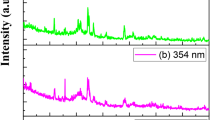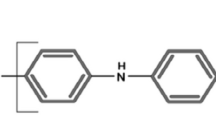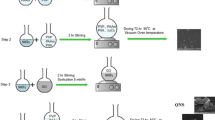Abstract
The nebulizer spray pyrolysis (NSP) technique is employed to analyze the effect of samarium doping on the structural, morphological, optical, and electrical conductivity in Bi2S3 thin films deposited on bare glass substrates by varying the doping concentration from 0 to 3 wt %. Further, their photosensing properties are also studied to utilize the prepared Bi2S3:Sm thin films for photo-detecting applications. The Bi2S3:Sm thin films are found to be in an orthorhombic structure. The data from X-ray diffraction are used to calculate the value of crystallite size, microstrain, and lattice parameters, as well as the volume of the unit cell. 2% Sm-doped Bi2S3 film exhibited a maximum crystallite size of 38 nm and a lower micro-strain value. FESEM micrographs of 2% Sm-doped film show well-defined larger grains. The optical band gap is found to vary between 2.02 and 2.26 eV when the Sm doping concentration is varied. These thin films' absorption is higher around the ultraviolet region of the electromagnetic spectra. The electrical properties exhibited an increase in photocurrent under illumination. A higher responsivity of 9.57 × 10–1 AW–1, detectivity of 1.97 × 1011 Jones, and external quantum efficiency of 309% are recorded for Bi2S3:Sm (2%) thin film. The response and recovery time of the Bi2S3:Sm (2%)-based photodetector are observed to be 1.6 and 1.8 s, respectively. These favorable characteristics of samarium-doped Bi2S3 thin films recommend its potential usage in low-cost, high-performance UV photodetectors.









Similar content being viewed by others
Data availability
The corresponding author’s data supporting this study's findings are available upon reasonable request.
References
M.-B. Lien, C.-H. Liu, I.Y. Chun, S. Ravishankar, H. Nien, M. Zhou, J.A. Fessler, Z. Zhong, T.B. Norris, Ranging and light field imaging with transparent photodetectors. Nat. Photonics 14(3), 143–148 (2020). https://doi.org/10.1038/s41566-019-0567-3
G. Konstantatos, Current status and technological prospect of photodetectors based on two-dimensional materials. Nat. Commun. 9(1), 5266 (2018). https://doi.org/10.1038/s41467-018-07643-7
R. Yotter, D. Wilson, A review of photodetectors for sensing light-emitting reporters in biological systems. Sensors J IEEE 3, 288–303 (2003). https://doi.org/10.1109/JSEN.2003.814651
Y. Zhou, X. Qiu, Z. Wan, Z. Long, S. Poddar, Q. Zhang, Y. Ding, C.L.J. Chan, D. Zhang, K. Zhou et al., Halide-exchanged perovskite photodetectors for wearable visible-blind ultraviolet monitoring. Nano Energy 100, 107516 (2022). https://doi.org/10.1016/j.nanoen.2022.107516
H. Melchior, M.B. Fisher, F.R. Abrams, Photodetectors for optical communication systems. Proc. IEEE 58(10), 1466–1486 (1970). https://doi.org/10.1109/PROC.1970.7972
S. Liu, X. Zhang, X. Gu, D. Ming, Photodetectors based on two dimensional materials for biomedical application. Biosens. Bioelectron. 143, 111617 (2019). https://doi.org/10.1016/j.bios.2019.111617
S. Bellani, A. Bartolotta, A. Agresti, G. Calogero, G. Grancini, A. Di Carlo, E. Kymakis, F. Bonaccorso, Solution-processed two-dimensional materials for next-generation photovoltaics. Chem. Soc. Rev. 50(21), 11870–11965 (2021). https://doi.org/10.1039/D1CS00106J
S. Li, Z. Zhang, X. Chen, W. Deng, Y. Lu, M. Sui, F. Gong, G. Xu, X. Li, F. Liu et al., A high-performance in-memory photodetector realized by charge storage in a van Der Waals MISFET. Adv Mater. 34(10), 2107734 (2022). https://doi.org/10.1002/adma.202107734
D. Li, C. Lan, A. Manikandan, S. Yip, Z. Zhou, X. Liang, L. Shu, Y.-L. Chueh, N. Han, J.C. Ho, Ultra-fast photodetectors based on high-mobility indium gallium antimonide nanowires. Nat. Commun. 10(1), 1664 (2019). https://doi.org/10.1038/s41467-019-09606-y
A.G.U. Perera, H.X. Yuan, S.K. Gamage, W.Z. Shen, M.H. Francombe, GaAs multilayer P+-I homojunction far—infrared detectors. J. Appl. Phys. 81(7), 2–5 (1997). https://doi.org/10.1063/1.364356
F. Sizov, V. Zabudsky, S. Dvoretskii, V. Petryakov, O. Golenkov, K. Andreyeva, Z. Tsybrii, Two-color detector: mercury-cadmium-telluride as a terahertz and infrared detector. Appl. Phys. Lett. 106, 82104 (2015). https://doi.org/10.1063/1.4913590
B. Chitara, B.S.C. Kolli, F. Yan, Near-infrared photodetectors based on 2D Bi2S3. Chem. Phys. Lett. 804, 139876 (2022). https://doi.org/10.1016/j.cplett.2022.139876
N. Cates, M. Bernechea, Research update: bismuth based materials for photovoltaics. APL Mater. 6(8), 84503 (2018). https://doi.org/10.1063/1.502654
R. Lokhande, S. Thakur, P.A. Chate, Chemical deposition of bismuth sulphide thin films using malonic acid ligand. J. Mater. Sci. Mater. Electron. (2020). https://doi.org/10.1007/s10854-020-03658-3
Y. Chen, B. Mei, H. Liu, Z. Sun, H. Zhang, One-step rapid deposition of Bi2S3 thin film and comprehensive study of its photoelectrochemical activity. Cryst. Growth Des. 22(7), 4203–4209 (2022). https://doi.org/10.1021/acs.cgd.2c00230
S. Mansoor Ali, S. Aldawood, M.S. AlGarawi, S.S. AlGhamdi, H. Kassim, A. Aziz, Influence of gamma irradiation on structural, optical, and electrical characterization of Bi2S3 thin films. J. Mater. Sci. Mater. Electron. 33(24), 18982–18990 (2022). https://doi.org/10.1007/s10854-022-08711-x
T. Fazal, S. Iqbal, M. Shah, B. Ismail, N. Shaheen, A.I. Alharthi, N.S. Awwad, H.A. Ibrahim, Correlation between structural, morphological and optical properties of Bi2S3 thin films deposited by various aqueous and non-aqueous chemical bath deposition methods. Results Phys. 40, 105817 (2022). https://doi.org/10.1016/j.rinp.2022.105817
V.V. Killedar, S.N. Katore, C.H. Bhosale, Preparation, and characterization of electrodeposited Bi2S3 thin films prepared from non-aqueous media. Mater. Chem. Phys. 64(2), 166–169 (2000). https://doi.org/10.1016/S0254-0584(99)00259-X
Y.-C. Liang, T.-H. Li, Controllable morphology of Bi2S3 nanostructures formed via hydrothermal vulcanization of Bi2O3 thin-film layer and their photoelectrocatalytic performances. Nanotechnol Rev. 11(1), 284–297 (2022). https://doi.org/10.1515/ntrev-2022-0016
J. Arumugam, A. George, A.D. Raj, A.A. Irudayaraj, R.L. Josephine, S.J. Sundaram, A.M. Al-Mohaimeed, W.A. Al-onazi, M.S. Elshikh, K. Kaviyarasu, Construction and characterization of photodiodes prepared with Bi2S3 nanowires. J. Alloys Compd. 863, 158681 (2021). https://doi.org/10.1016/j.jallcom.2021.158681
Ö. Karsandık, T. Özdal, H. Kavak, Influence of thickness and annealing temperature on properties of solution-processed bismuth sulfide thin films. J. Mater. Sci. Mater. Electron. 33(22), 18014–18027 (2022). https://doi.org/10.1007/s10854-022-08662-3
K.V. Ganapathy, K. Tamilarasan, C. Rangasami, A.M.S. Arulanantham, Effect of spray volume on the properties of Cu2ZnSnS4 absorber thin film fabricated through nebulizer assisted spray pyrolysis technique. Mater. Res. Express (2019). https://doi.org/10.1088/2053-1591/ab3eee
R. Sakthivel, S. Kubendhiran, S.M. Chen, Facile one-pot sonochemical synthesis of Ni doped bismuth sulphide for the electrochemical determination of promethazine hydrochloride. Ultrason. Sonochem. 54, 68–78 (2019). https://doi.org/10.1016/j.ultsonch.2019.02.013
S. Wang, J. Li, Y. Fu, Z. Zhuang, Z. Liu, Indium-doped mesoporous Bi2S3-based electrochemical interface for highly sensitive detection of Pb(II). Microchem. J. 166, 106251 (2021). https://doi.org/10.1016/j.microc.2021.106251
F. Du, Z. Lai, H. Tang, H. Wang, C. Zhao, Construction and application of BiOCl/Cu-doped Bi2S3 composites for highly efficient photocatalytic degradation of ciprofloxacin. Chemosphere 287, 132391 (2022). https://doi.org/10.1016/j.chemosphere.2021.132391
Z.-Y. Wang, J. Guo, J. Feng, Z.-H. Ge, Effects of NbCl5-doping on the thermoelectric properties of polycrystalline Bi2S3. J. Solid State Chem. 297, 122043 (2021). https://doi.org/10.1016/j.jssc.2021.122043
J. Guo, Y.-K. Zhu, L. Chen, Z.-Y. Wang, Z.-H. Ge, J. Feng, High thermoelectric properties realized in earth abundant Bi2S3 bulk materials via Se and Cl Co-doping in solution synthesis process. J. Mater. Sci. Technol. 100, 51–58 (2022). https://doi.org/10.1016/j.jmst.2021.05.057
Q. Chen, P. Lu, Y. Hao, M. Zhang, Morphology, structure and properties of Bi2S3 nanocrystals: role of mixed valence effects of cobalt. J. Mater. Sci. Mater. Electron. 32(19), 24459–24483 (2021). https://doi.org/10.1007/s10854-021-06925-z
M. Iqbal, A. Ibrar, A. Ali, S. Hussain, S. Shad, S. Ullah, T. Alshahrani, J. Hakami, F. Khan, K.H. Thebo, Facile synthesis of Mn doped Bi2S3 photocatalyst for efficient degradation of organic dye under visible-light irradiation. J. Mol. Struct. 1267, 133598 (2022). https://doi.org/10.1016/j.molstruc.2022.133598
H. Moreno-García, S. Messina, M. Calixto-Rodriguez, H. Martínez, Physical properties of chemically deposited Bi2S3 thin films using two post-deposition treatments. Appl. Surf. Sci. 311, 729–733 (2014). https://doi.org/10.1016/j.apsusc.2014.05.147
S.L. Jenish, S. Valanarasu, B. Prakash, K. Veerathangam, S. Vinoth, A.M. Al-Enzi, M. Ubaidullah, V.R.M. Reddy, A. Karim, Improved optical and electrical properties of Fe doped ZnO nanostructures facilely deposited by low-cost SILAR method for photosensor applications. Surf Interfac 31, 102071 (2022). https://doi.org/10.1016/j.surfin.2022.102071
H.E. Okur, N. Bulut, T. Ates, O. Kaygili, Structural and optical characterization of Sm-doped ZnO nanoparticles. Bull. Mater. Sci. 3, 1–9 (2019). https://doi.org/10.1007/s12034-019-1877-2
T.O. Ajiboye, D.C. Onwudiwe, Bismuth sulfide based compounds: properties, synthesis, and applications. Results Chem. 3, 100151 (2021). https://doi.org/10.1016/j.rechem.2021.100151
T. Patel, V. Sharma, R. Bhatt, V. Ganesan, G. Okram, A catalyst-free new polyol method synthesized hot-pressed Cu-doped Bi2S3 nanorods and their thermoelectric properties. Nano Res. (2016). https://doi.org/10.1007/s12274-016-1207-6
A. Jayachandran, A. George, D. Raj, M. Selvaraj, A.A. Alphonse, T. Pazhanivel, J. Rathinadurai Louis, B. Kandasamy, Role of surfactant in tailoring the properties of Bi2S3 nanoparticles for photocatalytic degradation of methylene blue dye. J. Mater. Sci. Mater. Electron. 33, 1–12 (2022). https://doi.org/10.1007/s10854-021-07007-w
A. Sarkar, A.B. Ghosh, N. Saha, A.K. Dutta, D.N. Srivastava, P. Paul, B. Adhikary, Enhanced photocatalytic activity of Eu-doped Bi2S3 nanoflowers for degradation of organic pollutants under visible light illumination. Catal. Sci. Technol. 5(8), 4055–4063 (2015). https://doi.org/10.1039/C5CY00473J
X. Yu, C. Cao, H. Zhu, Synthesis and photoluminescence properties of Bi2S3 nanowires via surfactant micelle-template inducing reaction. Solid State Commun. 134(4), 239–243 (2005). https://doi.org/10.1016/j.ssc.2005.01.035
A.K. Srivastava, M. Deepa, N. Bahadur, M.S. Goyat, Influence of Fe doping on nanostructures and photoluminescence of sol–gel derived ZnO. Mater. Chem. Phys. 114(1), 194–198 (2009). https://doi.org/10.1016/j.matchemphys.2008.09.005
K. Bandopadhyay, J. Mitra, Zn interstitials and O vacancies responsible for N-type ZnO: what do the emission spectra reveal? RSC Adv. 5(30), 23540–23547 (2015). https://doi.org/10.1039/C5RA00355E
D. Behera, B.S. Acharya, Nano-star formation in Al-doped ZnO thin film deposited by dip-dry method and its characterization using atomic force microscopy, electron probe microscopy, photoluminescence, and laser raman spectroscopy. J. Lumin. 128(10), 1577–1586 (2008). https://doi.org/10.1016/j.jlumin.2008.03.006
D.R. Kumar, K.S. Ranjith, L.R. Nivedita, R.T.R. Kumar, Effect of samarium doping on structural, optical and magnetic properties of vertically aligned ZnO nanorod arrays. J. Rare Earths 35(10), 1002–1007 (2017). https://doi.org/10.1016/S1002-0721(17)61005-6
R. Panmand, G. Kumar, S. Mahajan, M. Kulkarni, D.P. Amalnerkar, B. Kale, S. Gosavi, Functionality of bismuth sulfide quantum dots/wires-glass nanocomposite as an optical current sensor with enhanced verdet constant. J. Appl. Phys. 109, 33101 (2011). https://doi.org/10.1063/1.3533398
J. Xu, J. Yang, P. Zhang, Q. Yuan, Y. Zhu, Y. Wang, M. Wu, Z. Wang, M. Chen, Preparation of 2D square-like Bi2S3 -BiOCl heterostructures with enhanced visible light-driven photocatalytic performance for dye pollutant degradation. Water Sci. Eng. (2017). https://doi.org/10.1016/j.wse.2017.12.010
S. Morawiec, J. Holovský, M.J. Mendes, M. Müller, K. Ganzerová, A. Vetushka, M. Ledinský, F. Priolo, A. Fejfar, I. Crupi, Experimental quantification of useful and parasitic absorption of light in plasmon-enhanced thin silicon films for solar cells application. Sci. Rep. 2016(6), 1–10 (2015). https://doi.org/10.1038/srep22481
A. Kathalingam, S. Valanarasu, T. Ahamad, S.M. Alshehri, H.-S. Kim, Spray pressure variation effect on the properties of CdS thin films for photodetector applications. Ceram. Int. 47(6), 7608–7616 (2021). https://doi.org/10.1016/j.ceramint.2020.11.100
Y. Kamnik, I. Berkutov, V. Andrievskii, Spin-orbit interaction in thin bismuth films. Low Temp. Phys. 31, 326 (2005). https://doi.org/10.1063/1.1884436
S. Aveline, Y.C. Chan, Y.L. Lam, Evaluation of Schottky contact parameters in metal–semiconductor–metal photodiode structures. Appl. Phys. Lett. 77(2), 274–276 (2000). https://doi.org/10.1063/1.126948
B. Hwang, Y. Park, J.-S. Lee, Impact of grain size on the optoelectronic performance of 2d ruddlesden-popper perovskite-based photodetectors. J. Mater. Chem. C (2021). https://doi.org/10.1039/D0TC04350H
R. Ade, S.S. Kumar, S. Valanarasu, S.S. Kumar, S. Sasikumar, V. Ganesh, Y. Bitla, H. Algarni, I.S. Yahia, Enhanced optoelectronic properties of Ti-doped ZnO nanorods for photodetector applications. Ceram. Int. 47(17), 24031–24038 (2021). https://doi.org/10.1016/j.ceramint.2021.05.112
M. Shkir, A. Ben, G. Trabelsi, F.H. Alkallas, S. Alfaify, B. Pandit, Improved optoelectronic properties of nanostructured Eu doped Bi2S3 thin films for the detection of U.V. light. Crystals (2022). https://doi.org/10.3390/cryst12101329
S. Rajeswari, M. Ibrahim, I. Raj, M. Imran, S. Alfaify, M. Shkir, Noticeably enhanced photosensing properties of Fe-doped Bi2S3 thin films developed by nebulizer spray pyrolysis technique for photosensor applications. Sensors Actuators A Phys. 345, 113759 (2022). https://doi.org/10.1016/j.sna.2022.113759
W. Huang, C. Xing, Y. Wang, Z. Li, L. Wu, D. Ma, X. Dai, Y. Xiang, J. Li, D. Fan et al., Facile fabrication and characterization of two-dimensional bismuth(iii) sulfide nanosheets for high-performance photodetector applications under ambient conditions. Nanoscale 10(5), 2404–2412 (2018). https://doi.org/10.1039/c7nr09046c
J. Chao, S. Xing, Z. Liu, X. Zhang, Y. Zhao, L. Zhao, Q. Fan, Large-scale synthesis of Bi2S3 nanorods and nanoflowers for flexible near-infrared laser detectors and visible light photodetectors. Mater. Res. Bull. 2018(98), 194–199 (2017). https://doi.org/10.1016/j.materresbull.2017.10.026
S. Veeralingam, S. Badhulika, Bi-metallic sulphides 1D Bi2S3 microneedles/1D RuS2 nano-rods based N-N heterojunction for large area, flexible and high-performance broadband photodetector. J. Alloys Compd. 885, 160954 (2021). https://doi.org/10.1016/j.jallcom.2021.160954
A. Das Mahapatra, D. Basak, Enhanced ultraviolet photosensing properties in Bi2S3 nanoparticles decorated ZnO nanorods’ heterostructure. J. Alloys Compd. 797, 766–774 (2019). https://doi.org/10.1016/j.jallcom.2019.05.160
X. Xu, C. Fan, Y. Wang, Z. Qi, B. Dai, H. Jiang, S. Wang, Q. Zhang, In Plane epitaxy of Bi2S3 nanowire arrays for ultrasensitive NIR photodetectors. Phys. Status Solidi Rapid Res. Lett. (2020). https://doi.org/10.1002/pssr.202000384
X. Pan, T. Zhang, Q. Lu, W. Wang, Z. Ye, High responsivity ultraviolet detector based on novel SnO2 nanoarrays. RSC Adv. 9, 37201–37206 (2019). https://doi.org/10.1039/C9RA03999F
Acknowledgements
The authors extend their appreciation to the Deanship of Scientific Research at K.K.U. for funding to carry this work through the research groups program under grant number R.G.P. 2/147/43.
Author information
Authors and Affiliations
Corresponding author
Ethics declarations
Conflict of interest
On behalf of all authors, the corresponding author states that there is no conflict of interest.
Ethical approval
This article doesn’t contain any studies involving animals performed by any authors. Also, this article does not have any studies involving human participants performed by any of the authors.
Additional information
Publisher's Note
Springer Nature remains neutral with regard to jurisdictional claims in published maps and institutional affiliations.
Rights and permissions
Springer Nature or its licensor (e.g. a society or other partner) holds exclusive rights to this article under a publishing agreement with the author(s) or other rightsholder(s); author self-archiving of the accepted manuscript version of this article is solely governed by the terms of such publishing agreement and applicable law.
About this article
Cite this article
Gunavathy, K.V., Arulanantham, A.M.S., Raj, I.L.P. et al. Influence of samarium doping on enhancing the photosensing capability of nebulizer-sprayed bismuth sulfide thin films. Appl. Phys. A 129, 141 (2023). https://doi.org/10.1007/s00339-023-06389-4
Received:
Accepted:
Published:
DOI: https://doi.org/10.1007/s00339-023-06389-4




